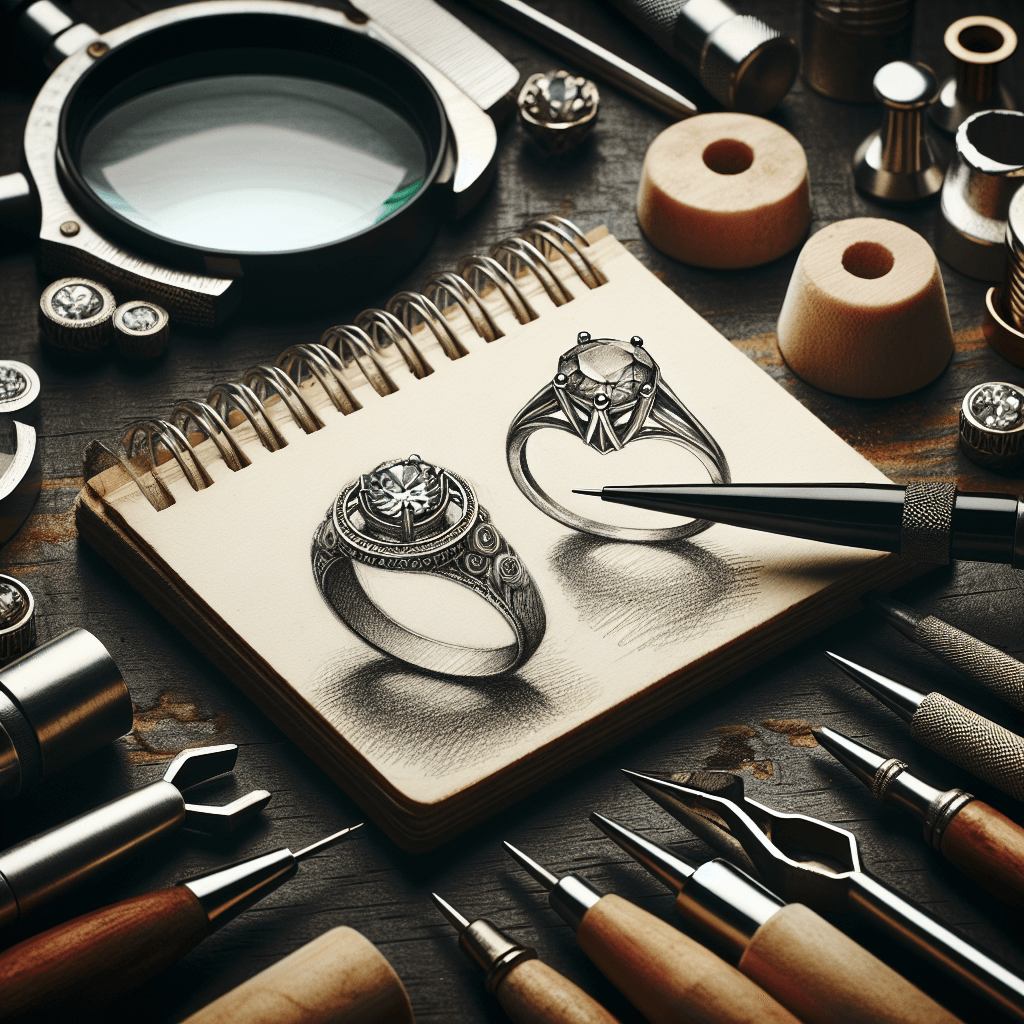Is it Possible for a Jeweller to Copy a Ring?
Is it Possible for a Jeweller to Copy a Ring? Let’s explore a gem of a question that you may have pondered at some point in your life – “Is it Possible for a Jeweller to Copy a Ring?” You’ll find this article has all the glittering insights into the world of jewellery making, specifically focusing on the skills and techniques employed by jewellers to potentially replicate a ring. You are about to embark on a fascinating journey through the intricate and precise world of jewellery reproduction. Buckle up and grab a jeweller’s loupe; you’re in for a sparkle-filled ride!

Understanding the Question: Can a Jeweller Copy a Ring
The question ‘Can a jeweller copy a ring?’ may seem relatively straightforward. However, the answer is more complex and entails not only technical aspects but also ethical and legal considerations. This article aims to provide a comprehensive breakdown of this multifaceted question and guide you through the various factors surrounding the replication of jewelry.
Defining ‘copying’ a ring
In the context of jewellery, copying a ring does not imply the simple act of copying. Instead, it could represent two different concepts: the process of exact replication or the creation of a ring inspired by an original piece. An exact replica would require the matching of every minute detail, from the design and measurements to the intricacy of the pattern. On the other hand, an inspired version of a ring would maintain the general aesthetic of the original but might incorporate different materials, changes in design, or other unique elements.
Legal and ethical aspects of copying
There are legal and ethical implications involved in copying a ring. If a jeweller were to replicate a ring that is copyrighted or trademarked, it could lead to legal action. In addition to legality, there are also ethical considerations to take into account. Copying a unique design without permission or proper credit to the original designer could be regarded as an infringement on their creative rights.
Tools and Techniques Used by Jewellers
Copying a ring is a meticulous process that requires skills, time, and an array of tools and technologies. Some jewellers use traditional methods, while others have integrated modern technology into their practices.
Traditional jewellery making tools
In traditional jewellery making, various tools are used: jeweller’s saws for cutting metals, files for refining and shaping, hammers for work hardening and shaping metal, pliers for bending and manipulating metal, and many others. Mandrels and ring sizers help to accurately measure and recreate the precise size of a ring.
Modern technology in the jewellery industry
Modern technology is dramatically reshaping the jewellery industry. Computer-aided design (CAD) and computer-aided manufacturing (CAM) enable jewellers to create precise and intricate designs that minimize waste. 3D printing can be used to create tangible jewellery prototypes, providing a solid framework on which the final piece can be built.
Process of crafting a replica ring
The process of crafting a replica ring depends on the method used. For traditional methods, a wax model is often first created to match the original ring, then cast into metal. In modern techniques, the original ring is scanned into a 3D model through CAD software, then meticulously crafted or 3D printed.

Methods of Ring Replication
Replicating a ring involves the meticulous crafting of every component to resemble the original piece as accurately as possible.
Creating molds from original pieces
In some cases, creating a mold from the original ring is an effective way to replicate its shape and details. The process involves making a replica of the ring in wax, then casting it into metal. This method works best for simpler designs, as it may not capture intricate details.
Using 3D imaging and printing
3D imaging and printing have revolutionized the jewellery industry. High-resolution 3D scanners can capture every small detail of a ring, including its proportions and surface texture. With this digital model, jewellers can either handmade the piece or create it using a 3D printer.
Handcrafting duplicates based on specifications
When rings have personalized, intricate designs, they may require handcrafting. With skills honed over years of experience, artisan jewellers can recreate rings based on photos, illustrations, or detailed descriptions. Although the most time-consuming method, this often results in the most accurate replicas.
Consideration of Gemstones in Replication
In copying rings, an essential component to consider is the gemstones. They add colour, sparkle, and value to a piece and can often be the most challenging part to replicate.
Copy vs. exact replication
Replicating a ring isn’t always about creating an exact copy. Sometimes it’s about capturing the essence of the original piece. This is particularly relevant when considering gemstones. Gemstone size, cut, and quality can greatly impact the final look and cost of the ring. In some cases, a similar but affordable alternative might be used instead.
Challenges in matching gemstones
Each gemstone is unique and irreplaceable, making it extremely challenging to find a perfect match. Their cut, clarity, colour, carat, and overall quality are factors to consider. High-quality gemstones with similar characteristics can be hard to find and are usually more expensive.
Alternatives to hard-to-find or expensive gemstones
When the original gemstones are hard to find or too expensive, jewellers often use alternatives. Popular options include synthetic or lab-created gemstones, which look remarkably similar to natural ones. Or semi-precious stones, which offer a wide range of colours and are more affordable.

Reproduction of Antiques and Vintage Pieces
Reproducing antique or vintage rings poses additional challenges due to their unique construction and rarity of materials. However, with careful observation and masterful craftsmanship, it is possible to recreate these beautiful pieces.
Understanding unique construction of vintage and antique rings
Antique and vintage rings often contain designs and techniques that aren’t commonly used in modern jewellery. Filigree work, hand engraving, and milgrain details are just a few examples. Understanding these unique constructions is crucial in faithfully replicating these pieces.
Feasibility of reproducing antique pieces
Although some antique pieces can be carefully copied, others are simply too intricate or contain materials too difficult to source to be feasible for replication. In these cases, often the goal is to create a ring inspired by the original, rather than an identical copy.
Preserving the original while creating a copy
Reproducing antique or vintage pieces necessitates certain precautions to preserve the original. It’s essential not to cause any damage or change to the vintage piece while attempting to duplicate it. This might involve taking detailed 3D scans or making moulds without affecting the original piece.
Legality and Ethics of Replicating Rings
Considerations of legality and ethics are crucial when replicating a ring.
Trademark and copyright issues
Jewellery designs can be subject to trademark, copyright, and intellectual property rights laws. Copying a design without permission from the owner may result in legal repercussions. Before replicating a ring, checking for possible legal implications is vital.
Ethical considerations in copying designs
Beyond legal aspects, there are ethical concerns to also be aware of when copying a ring. Respecting the creative work of original jewellery designers is important. Copying a designer’s work without appropriate attribution can be viewed as unethical and disrespect of their creativity.
Disclosure and transparency with customers
When selling a replicating ring, honesty, disclosure, and transparency with customers are of utmost importance. Customers should be fully aware that what they are purchasing is a replica and not the/original design.

Pricing and Value Considerations
The cost and value of replicating a ring are often influenced by many factors.
Labour and material costs for replicas
Creating a replica can be labour-intensive, especially for complex designs, and this can significantly influence the price. The cost of materials, particularly precious metals and gemstones, would also impact the final cost of the copy.
Possible impact on the value of the original
Replicating a ring might impact the value of the original, especially for designer or one-of-a-kind pieces. It’s always advisable to discuss possible impacts on value with a professional valuer or jeweller before proceeding with replication.
Price comparison between originals and copies
While replicating a ring may seem like a cost-effective alternative, keep in mind that labour and material costs, combined with the jeweller’s expertise, can sometimes make replicated rings as expensive as originals.
Potential Reasons to Copy a Ring
There are a myriad of motivations for someone to consider having a ring copied.
Emotional attachment to original pieces
People often want to copy rings due to their sentimental value. Whether it’s their grandparent’s wedding ring or a beloved piece that has been worn for many years, making a copy can help preserve the precious memories attached to it.
Replacing lost or damaged items
One common reason to duplicate a ring is when the original has been lost or irreparably damaged. Having a ring replicated can provide some solace in such unfortunate scenarios.
Creating matching sets or pieces
Replicating rings can also be useful when one desires to create matching sets or pieces. Whether it’s two of the same rings for a pair of siblings or a matching engagement and wedding ring for oneself, copying rings can help achieve uniformity.

Customer Involvement in the Replication Process
Customers play a significant role in the successful replication of a ring.
Sharing the original design specifications
Customers often provide the original design specifications, such as photos, descriptions, or even the actual ring. This helps the jeweller understand the intricacies of the original piece and efficiently translate them into the copied version.
Customers’ participation in material selection
Customers also contribute to the material selection process. The jeweller would educate the customer on various material options, and the customer selects based on their preference and budget.
Approvals and adjustments during creation
Throughout the creation process, the customer often provides approvals and feedback. The jeweller may provide a prototype or CAD model for approval, make adjustments based on feedback, and gradually refine the piece until the customer is satisfied with the result.
Use of Replicas in Fashion and Jewellery Industry
The use of replicas has become integral in the fashion and jewelry industry. They help democratize luxury, allowing more people to enjoy the allure of high-end designs without breaking the bank. Discovering the Best Jewellery Designer: Who is It?
Benefits of replication in mass-production
In mass-production, replicating a design can ensure consistency across all pieces. Consumers can expect a uniform quality and style across different pieces, which bolsters the brand’s reliability.
Trends in designed replicas of high-end pieces
Replicas of high-end jewellery have been trending for some time. These pieces bring the glamour and opulence of exclusive designs within the reach of the average consumer.
Impact of replicas on the fashion industry
The rise of replica pieces can have both positive and negative impacts on the fashion industry. On one side, they enable more people to enjoy beautiful designs; on the other, they may affect the value and prestige associated with original designs.
In conclusion, while it’s possible for a jeweller to copy a ring, it’s essential to understand the many different factors involved. An array of skills, tools, and technical understanding are required, along with an ethical and legal consciousness and respect for the original design. By navigating these considerations judiciously, it becomes possible to replicate a cherished ring while honouring the art of jewellery making at the same time.



